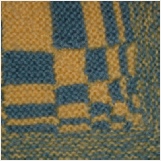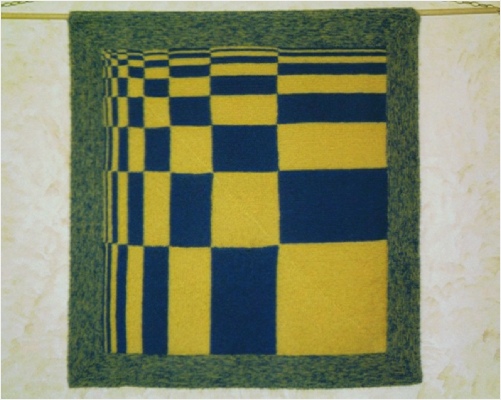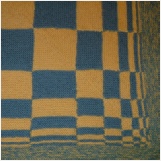

Click to read general information about afghans



Buy a pattern
for this afghan
on the order form
 Buy now
Buy now


FIBRENACCI
Based on the Fibonacci Sequence in two directions.
The series is 0, 1, 1, 2, 3, 5, 8, 13, 21, 34, 55, 89...
Each term is found by adding together the two previous terms.
The afghan design omits the first ‘1’ in the series.


Scroll down for more information about
Fibrenacci

RELATED DESIGNS
FIBONACCI AFGHANS
FIBONACCI CUSHION
PUPPETS

CONSTRUCTION INFORMATION
The version shown was made in L-
It could be made in two large triangles, joined on the diagonal, using several balls of yarn at once.

KNITTING INFORMATION
Any yarn and needles can be used. The choice of yarn will affect the overall size of the afghan.
The size can be altered by adding more stripes but the sizes of the pieces increase dramatically as each extra stripe is added.
Click to see
larger pictures



On one notable occasion I took Fibrenacci into school to use with a low-
We talked about squares, rectangles, alternating colours, the squares lying on the diagonal, etc. Then came the business of identifying the pattern of numbers. There was one extremely awkward and aggressive girl in the group who rarely put pen to paper in Maths lessons. I decided the safest place for Abida to be was at the front, counting the ridges. I was writing them on the board. The rest were trying to find a pattern of numbers.
When we had about six or seven terms on the board Abida suddenly flew across the room and hurled herself at another girl (as she was apt to do!). Plan failed? No! She merely wrestled a calculator from the seated girl, rushed off to her desk and, within seconds, gave us the next term from her calculator, without having to count. Abida was reluctant to divulge how she did it but others eventually worked it out for themselves. She sat for the rest of the lesson generating more and more terms and, at the end of the lesson refused to leave (for which the next teacher was very grateful). She never caused a problem in Maths again!
Prior to making this we had created many black and white opart drawings using blocks to represent the sequence both up and across the page. Some of these drawings were extremely complex where areas were reflected and rotated or changed in scale. They produced some pronounced 3D effects. Narrower blocks can lead the eye to believe that blocks and stripes are further away so a flat surface might start to look like a tube curving away.
For Fibrenacci we chose the simplest form of using the sequence at the same scale in both directions. The pieces are worked as a series of L shapes with a diagonal join from top left to bottom right.